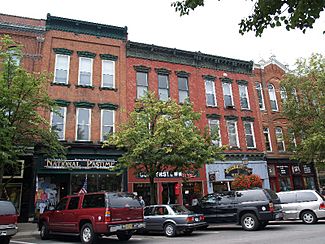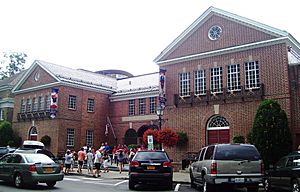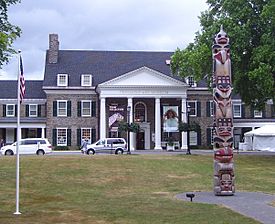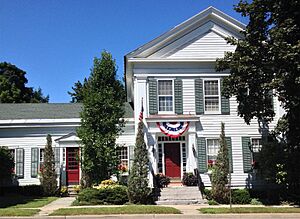Cooperstown, New York facts for kids
Quick facts for kids
Cooperstown, New York
|
|
|---|---|
| Village of Cooperstown | |

Main Street, part of the Cooperstown Historic District
|
|
| Country | United States |
| State | New York |
| Region | Central New York |
| County | Otsego |
| Town | Otsego |
| Area | |
| • Total | 1.84 sq mi (4.78 km2) |
| • Land | 1.64 sq mi (4.23 km2) |
| • Water | 0.21 sq mi (0.54 km2) |
| Elevation | 1,227 ft (374 m) |
| Population
(2020)
|
|
| • Total | 1,794 |
| • Density | 1,097.25/sq mi (423.74/km2) |
| Time zone | UTC−5 (Eastern (EST)) |
| • Summer (DST) | UTC−4 (EDT) |
| ZIP Code |
13326
|
| Area code(s) | 607 |
| FIPS code | 36-18047 |
| GNIS feature ID | 0979671 |
| Website | www.cooperstownny.org |
Cooperstown is a small village in New York, United States. It's located in Otsego County, New York, right at the bottom of Otsego Lake. This village is famous for being the home of the National Baseball Hall of Fame and Museum.
Cooperstown is about 60 miles (97 km) west of Albany. In 2020, about 1,794 people lived there. Besides the Baseball Hall of Fame, you can also find the Farmers' Museum and the Fenimore Art Museum here. Many old buildings in the village are part of the Cooperstown Historic District, which helps protect their history.
Contents
Discovering Cooperstown's Past
Native American History
Long before Europeans arrived, Iroquois Native Americans lived around Cooperstown and Otsego Lake. The name Otsego comes from a Mohawk or Oneida word. It means "place of the rock." This refers to a large boulder in the lake called "Council Rock."
This rock is still visible from the shore today. It's believed that Native Americans used it as a meeting place. In 1957, a small piece of land near Council Rock became a public park.
How Cooperstown Started
The village of Cooperstown was founded by William Cooper in 1786. He bought a large area of land, about 10,000 acres (40 km²), in 1785. William Cooper later became a judge.
His son, James Fenimore Cooper, grew up in this new frontier town. James Fenimore Cooper became a famous American author. He wrote The Leatherstocking Tales, which includes the well-known book The Last of the Mohicans.
The village was first called "Village of Otsego" in 1807. Its name was changed to "Village of Cooperstown" in 1812. This was done to honor its founder, William Cooper.
Cooperstown Today: A Village of Museums

Cooperstown is most famous for the National Baseball Hall of Fame and Museum. It was started in 1939 by Stephen Carlton Clark. There's a story that Abner Doubleday invented baseball here in 1839. However, most baseball historians don't believe this story is true.
Besides the Baseball Hall of Fame, Cooperstown has other cool museums. The Farmers' Museum opened in 1944. It's on land that once belonged to James Fenimore Cooper. The Fenimore Art Museum is also a popular spot.
Many historic buildings in Cooperstown are listed on the National Register of Historic Places. This helps protect them for future generations.
Village Life and Tourism
Cooperstown's main street has changed over the years. It used to have many local shops and services. Today, many stores focus on tourists. They sell gifts and souvenirs, especially for baseball fans.
The Cooperstown Chamber of Commerce helps local businesses. It also acts as a visitor center for tourists. The village is now served by smaller airports nearby.
Cooperstown's Special Connections
Sister City
Cooperstown has a "sister city" in Windsor, Nova Scotia, Canada. This connection is because Windsor claims to be where ice hockey started. Cooperstown was once thought to be the birthplace of baseball.
Nature and Weather
Geography
Cooperstown covers about 1.6 square miles (4.1 km²). Most of it is land, but a small part is water. The Susquehanna River actually starts here, flowing out of Otsego Lake.
Major roads like New York State Route 28 and New York State Route 80 meet in Cooperstown.
Climate
Cooperstown has a climate with cold, snowy winters and warm summers. It gets a lot of rain and snow throughout the year. The coldest temperature ever recorded was -34°F (-37°C). The hottest was 99°F (37°C).
| Climate data for Cooperstown, New York, 1991–2020 normals, extremes 1893–present | |||||||||||||
|---|---|---|---|---|---|---|---|---|---|---|---|---|---|
| Month | Jan | Feb | Mar | Apr | May | Jun | Jul | Aug | Sep | Oct | Nov | Dec | Year |
| Record high °F (°C) | 65 (18) |
70 (21) |
87 (31) |
93 (34) |
92 (33) |
97 (36) |
99 (37) |
98 (37) |
97 (36) |
88 (31) |
79 (26) |
66 (19) |
99 (37) |
| Mean maximum °F (°C) | 53.7 (12.1) |
52.6 (11.4) |
62.1 (16.7) |
77.7 (25.4) |
85.0 (29.4) |
87.8 (31.0) |
88.6 (31.4) |
87.7 (30.9) |
84.4 (29.1) |
76.0 (24.4) |
65.4 (18.6) |
55.3 (12.9) |
90.9 (32.7) |
| Mean daily maximum °F (°C) | 23.3 (−4.8) |
26.1 (−3.3) |
34.5 (1.4) |
48.1 (8.9) |
60.4 (15.8) |
68.2 (20.1) |
72.6 (22.6) |
70.8 (21.6) |
63.8 (17.7) |
51.8 (11.0) |
39.2 (4.0) |
28.9 (−1.7) |
49.0 (9.4) |
| Daily mean °F (°C) | 18.4 (−7.6) |
20.2 (−6.6) |
28.4 (−2.0) |
41.0 (5.0) |
52.7 (11.5) |
61.3 (16.3) |
65.8 (18.8) |
64.1 (17.8) |
57.0 (13.9) |
45.6 (7.6) |
34.6 (1.4) |
25.0 (−3.9) |
42.8 (6.0) |
| Mean daily minimum °F (°C) | 13.6 (−10.2) |
14.2 (−9.9) |
22.2 (−5.4) |
34.0 (1.1) |
44.9 (7.2) |
54.4 (12.4) |
59.0 (15.0) |
57.4 (14.1) |
50.2 (10.1) |
39.4 (4.1) |
30.0 (−1.1) |
21.1 (−6.1) |
36.7 (2.6) |
| Mean minimum °F (°C) | −9.7 (−23.2) |
−6.4 (−21.3) |
1.4 (−17.0) |
20.2 (−6.6) |
30.3 (−0.9) |
39.5 (4.2) |
47.7 (8.7) |
45.0 (7.2) |
34.6 (1.4) |
25.2 (−3.8) |
13.4 (−10.3) |
0.4 (−17.6) |
−13.0 (−25.0) |
| Record low °F (°C) | −33 (−36) |
−34 (−37) |
−19 (−28) |
5 (−15) |
19 (−7) |
28 (−2) |
35 (2) |
29 (−2) |
21 (−6) |
12 (−11) |
−12 (−24) |
−30 (−34) |
−34 (−37) |
| Average precipitation inches (mm) | 3.10 (79) |
3.06 (78) |
3.61 (92) |
4.18 (106) |
3.71 (94) |
4.73 (120) |
4.64 (118) |
4.57 (116) |
4.21 (107) |
4.95 (126) |
3.24 (82) |
3.59 (91) |
47.59 (1,209) |
| Average snowfall inches (cm) | 21.7 (55) |
18.8 (48) |
17.6 (45) |
2.8 (7.1) |
0.1 (0.25) |
0.0 (0.0) |
0.0 (0.0) |
0.0 (0.0) |
0.0 (0.0) |
0.4 (1.0) |
5.9 (15) |
18.2 (46) |
85.5 (217.35) |
| Average extreme snow depth inches (cm) | 12.5 (32) |
14.8 (38) |
13.8 (35) |
2.5 (6.4) |
0.0 (0.0) |
0.0 (0.0) |
0.0 (0.0) |
0.0 (0.0) |
0.0 (0.0) |
0.3 (0.76) |
3.3 (8.4) |
9.0 (23) |
20.8 (53) |
| Average precipitation days (≥ 0.01 in) | 14.5 | 11.6 | 12.5 | 12.4 | 13.2 | 12.1 | 11.2 | 12.0 | 11.1 | 13.9 | 12.8 | 14.3 | 151.6 |
| Average snowy days (≥ 0.1 in) | 10.7 | 9.7 | 6.6 | 1.5 | 0.2 | 0.0 | 0.0 | 0.0 | 0.0 | 0.3 | 3.7 | 8.4 | 41.1 |
| Source 1: NOAA | |||||||||||||
| Source 2: National Weather Service | |||||||||||||
Fun Things to Do and See
Annual Events
The Baseball Hall of Fame Induction Ceremony happens every year. New members are officially added to the Hall of Fame. In 2020, the ceremony was canceled because of the COVID-19 pandemic.
The Glimmerglass Festival is a famous opera company near Cooperstown. It started in 1975. They perform in a special opera house built in 1987. It's known for its high-quality shows and new operas.
Tourism and Attractions
The Baseball Hall of Fame is the biggest attraction in Cooperstown. It brings in about 260,000 visitors every year. Over 17 million people have visited since it opened!
Other fun places to visit include:
- The Farmers' Museum, which shows what farm life was like long ago.
- The Fenimore Art Museum, with its amazing art collections.
- The Clark Sports Center, a huge fitness facility. The Hall of Fame Induction Ceremony is held here.
- The Fly Creek Cider Mill and Orchard for tasty treats.
- The Brewery Ommegang for those interested in how beer is made.
Sports in Cooperstown
The Clark Sports Center is a large recreation center. It has indoor and outdoor fields. The Hall of Fame induction ceremony takes place here each year.
Cooperstown is very connected to baseball. Many national baseball tournaments are held in the area. Cooperstown Dreams Park hosts youth baseball teams every summer. Some professional players, like David Price, have played there.
Cooperstown even had its own baseball team, the Cooperstown Hawkeyes. They played against other teams in the summer at Doubleday Field.
Famous People from Cooperstown
Many interesting people have lived in Cooperstown, either year-round or during the summer.
- Kenneth Bainbridge – a physicist who worked on the Manhattan Project.
- James Fenimore Cooper – the famous novelist who grew up here.
- William Cooper – the founder of the village.
- Abner Doubleday – a Civil War officer, though the story of him inventing baseball is not true.
- Bud Fowler – a baseball player and Hall of Famer.
- Samuel F. B. Morse – the inventor of the Morse code.
Cooperstown Writers
Besides James Fenimore Cooper, his daughter Susan Fenimore Cooper was also a writer. His great-great-grandson, Paul Fenimore Cooper, wrote children's books.
Modern authors like Lauren Groff have written stories set in Cooperstown. Marly Youmans, a novelist and poet, has also mentioned the area in her works.
The Clark Family's Impact
The Clark family has lived in Cooperstown since the mid-1800s. Their wealth came from owning part of the Singer Sewing Machine company. They own a lot of land and properties in and around Cooperstown.
The Clark family's trusts and foundations support many things in the village. They helped start the Baseball Hall of Fame and the Mary Imogene Bassett Hospital. They also donate money for scholarships, parks, and other community services.
Jane Forbes Clark, a current family heir, continues this support. She helps protect the village's natural beauty and oversees the family's many properties. The Clark Foundation donates millions of dollars each year to charities in the area.
Schools in Cooperstown
The Cooperstown Central School District has two main buildings. The Elementary School was built in the 1950s. The Cooperstown Junior/Senior High School was built in 1970 on land given by the Clark family.
Amazing Architecture
Cooperstown has many beautiful and historic buildings. Some original homes of the Cooper family are still standing. Otsego Hall, James Fenimore Cooper's home, is no longer there.
The Clark family also built many grand homes and buildings. "Fernleigh" is a large stone mansion built in 1869. "West Hill" is another beautiful home from 1928. These properties are very well maintained.
Edward Severin Clark built a farm complex in 1918. This is now the Farmers Museum. His stone manor, built in 1931, is now the Fenimore Art Museum.
Other important buildings include the Baseball Hall of Fame, The Otesaga Hotel, and Bassett Hospital. These buildings show off Cooperstown's rich architectural history.
The village offices and the Cooperstown Art Association are in a beautiful building. It was designed by Ernest Flagg, a famous architect. It was originally a YMCA and was given to the village in 1932.
Many buildings were designed or updated by Frank P. Whiting, another noted architect. He designed farm buildings for the Farmers Museum. He also designed his own home in the village.
Images for kids
See also
 In Spanish: Cooperstown (Nueva York) para niños
In Spanish: Cooperstown (Nueva York) para niños









